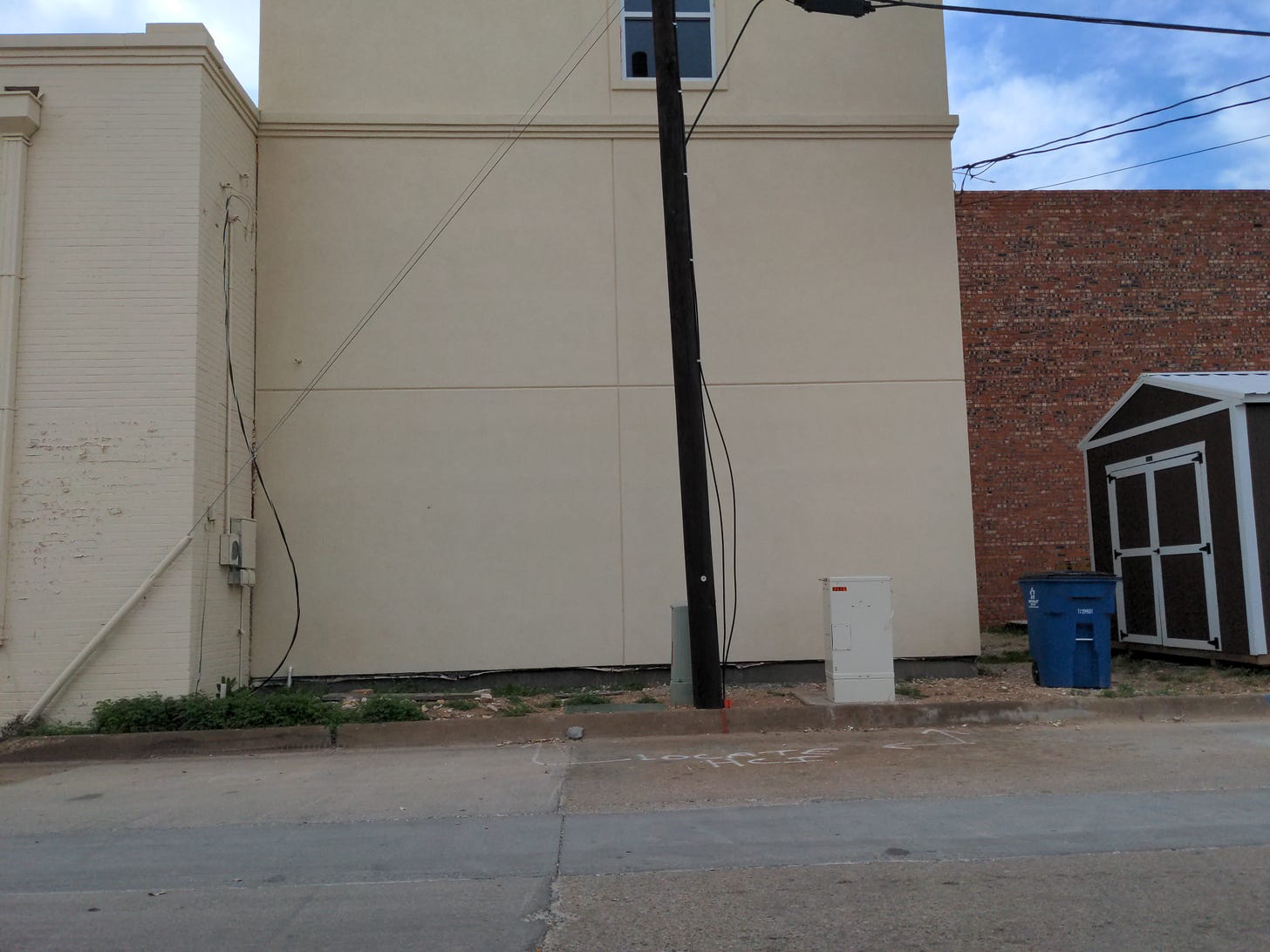First Amendment Concerns Raised by Historic Commission's Decision
On the 16th of February, a little known commission appointed by the city council to oversee the development of San Angelo’s historic downtown held its regularly scheduled meeting. The Design and Historic Review Commission or D.H.R.C. was established to ensure that construction and modifications to property in both the downtown district and along the Concho River keep with the historic aesthetics of the area.
At that meeting was veteran Jerry Vincent, the owner of the Blue Buffalo Art Gallery located on North Chadbourne Street. His applications that day, DD22-31 and CA22-10, in part, sought permission for the painting of a mural on the side of his building along West 2nd Street by another fellow veteran, Nester Hernandez, who is the art director for the Blue Buffalo.
The 25 by 25 foot mural as presented was denied by the D.H.R.C. The commissioners only approving a version which stipulated the artist change the mural, removing a rifle in the hands of the soldier it depicted. The commissioners argued that the gun was inappropriate due to the “all the violence going on” and for being “inappropriate for children.” This raises some concerns to the constitutionality of that decision.
The mural would have been a depiction of Mr. Hernandez’s experience in Afghanistan of him pulling a fellow soldier, wounded in combat, to a safe location with angelic eagle wings enveloping him. A smaller original version of the painting was submitted to the D.H.R.C. as part of the application.
City staff handled the initial processing of the application to ensure it met applicable zoning ordinances for the downtown area. According to city planner, Sherry Bailey, who was presenting the application, city staff recommended the application be denied due to the type of fencing that was included as part of the application, but not the mural. Two of the Commissioners objected to the Mural specifically.
Chairman David Mazur and commissioner Lisa Wallace took issue with the gun, or more specifically, what appeared to be an M4A1 rifle, a standard issue weapon in the U.S. Military. There was also a back and forth between the commissioners and city staff on if the mural had already been approved at an earlier meeting. City staff seemed unsure if the commissioners even had the authority to vote on the content of the mural in the first place. Select quotes below are from the meeting recording which I highly encourage you to watch for yourself here. Mr. Vincent’s application starts around 9:40.
David Mazur - “My question is when the mural is going to be presented, do we vote on the subject matter of the mural?”
Sherry Bailey - “No.”
David Mazur - “We don’t have any control over that? I would think we would.”
The city’s Planning and Development Services Director Jon James attempted to clarify.
Jon James - “It gets tricky, but yes. The short answer is you do have some ability to say what is or is not compatible with the downtown.”
There was bit more confusion as to whether they had already approved the mural at a previous date or not.
David Mazur - “I was on the board when we did that, and I don’t remember ever seeing, I can’t imagine that we would approve that mural. I mean, this is just my personal opinion, but somebody with a gun on it like that.”
After some more discussion, Mr. Vincent addresses the commissioners to provide more context on the mural.
“My art manager, Nester Hernandez, is that angel there. He was wounded in Afghanistan, almost died, pulled his crew out of a Humvee and when his shock was through, he woke up in Germany, in a hospital, and this is what he wants. You know, I heard some words about inappropriate because of the gun, and I just want it known that this man's life is in that mural. And he painted that.” - Jerry Vincent.
David Mazur - “I appreciate that. The only problem I have with that mural is the gun. I just don't think that is appropriate for the downtown area, this is my personal opinion, but with all the violence going on, we don't need a gun represented on a building that I feel like we are promoting for downtown.”
More talk ensued about the aforementioned confusion regarding prior approval. Commissioner Lisa Wallace then questioned how the mural even came before the D.H.R.C. Appearing to think there was some other city ordinance outlawing the depiction of firearms.
Lisa Wallace - “Is there not something set with the city and staff where a gun could be, I mean how'd this get to us? I'm surprised that the city doesn't already have something in place about images that could be violent or inappropriate for children.”
After questions regarding if the mural is a sign and the commission’s ability to approve or deny, Mr. James made it very clear about the city regulating violent images or things inappropriate for children in response to commissioner Wallace.
Jon James - “No, in fact, there are first amendment issues with that, that we have very little ability.”
At the end of the application hearing, commissioner Kenna Archer made the motion to approve the mural with the condition that the gun be removed.
Kenna Archer - “We would like to make a motion to approve the mural as presented to us without the gun included.”
Lisa Wallace - “Second.”
David Mazur - “We have a motion and a second, all in favor?”
All answered in the affirmative.
David Mazur - “Motion passes.”
To give some explanation to the process, anyone seeking make changes to buildings downtown or along the river are required by the city’s zoning ordinance Chapter 12, Exhibit A, Article 2, Section 211, Paragraph E and Chapter 12, Exhibit A, Article 2, Section 212 to obtain a “Certificate of Appropriateness” before they can proceed with construction, renovations, changes, or demolition.
The D.H.R.C. is empowered to approve or disapprove these applications by Chapter 2, Article 2.07.063, paragraph 10.
“(10) Approve or deny applications for certificates of appropriateness pursuant to provisions of the city zoning ordinance.”
There are two ways of interpreting this decision as far as I can see. One is as an infringement Mr. Vincent’s and Mr. Hernandez’s first amendment rights, and the other is the D.H.R.C.’s apparent lack of authority over artwork all together.
If the mural does fall under the city’s sign ordinance, than questions are raised on the regulation of content of said sign. The sign ordinance's definition of signs is broad enough that a mural could be interpreted as under its coverage. Article 12.04.002 defines a sign as,
“Any object, device, display, plaque, poster, painting, drawing or structure, or part thereof, which is used to advertise, identify, display, direct or attract attention to an object, person, institution, organization, business, product, service, message, event or location by any means, including words, letters, figures, design, symbols, fixtures, colors, illumination or projected images.”
Artwork by its very nature is meant to attract attention. And its will inevitably include colors, design, figures, etc. With this, the mural is covered under the sign ordinance which introduces restrictions on the local government’s ability to regulate based on content or message.
Two Supreme Court cases in recent years have had a significant impact on sign ordinances. It was found that a town had been enforcing sign regulations unequally depending on content of the signs in violation of the first amendment.
The first Supreme Court ruling came from Reed v. Town of Gilbert in 2015 where the court found the Town of Gilbert had imposed stricter regulations on signs advertising religious services than political and ideological signs. Any rules covering signs must be content neutral as per the ruling, meaning that the content of the sign cannot be taken into consideration when making such rules. The town failed to demonstrate they had met this requirement, unable to justify it via a concept in constitutional law called “strict scrutiny.” It essentially means the government must have a compelling interest to restrict a constitutional right and must do so in the least restrictive manor possible. Obviously, it failed. The court also found that the sign regulations were not content neutral, meaning they did not treat all signs as equal under the sign ordinance regardless of content of the message.
The court’s ruling was further solidified in a 2022 Supreme Court case. In City of Austin v. Reagan National Advertising of Austin, LLC, the city of Austin’s off premise sign regulation was found to be written in a content neutral manor that was consistent with the Reed ruling, thus providing an example of a content neutral sign ordinance and more clearly defining when strict scrutiny is to be applied.
The City of San Angelo made this clear in their own interpretation of the aforementioned case law in a city council meeting on November 11th, 2022. You can watch the meeting in its entirety here, the relevant portion starts around the 30 minute mark.
For background, if you keep up with local politics, you may have heard the name Zane White. Mr. White has been leading his own “crusade” against both the city and local business man, Lee Pfluger, owner of the Cactus Hotel. The entire ordeal is an article unto itself, so to keep it brief. Mr. White claims the city is failing to enforce its own sign ordinance against Mr. Pfluger in regards to the partially disassembled sign atop the hotel.
The city responded to Mr. White saying they could not enforce sign regulations based on the content of the sign as per the Supreme Court cases mentioned above. Councilman Tom Thompson read a prepared statement to that effect.
Tom Thompson - “Recent decisions by the US Supreme Court severely limit the ability of the city to find sign violations based upon the content of the sign rendering portions of our sign ordinance unconstitutional and unenforceable. Since the property owner changed the sign to read as it does intentionally and there are no structural or safety issues that have been found, the sign cannot be found abandoned or defective.”
The city’s attorney also weighed in.
Theresa James - “Until, as Tom said, there is a change in that case law, there is nothing we can do about what the sign says and we’re not finding there is anything structurally wrong or dangerous about the sign. So there is nothing else that we can do.”
The sign ordinance under Article 12.04 makes no mention of regulating signs based on the content of their message. Another ordinance, specifically referring to the Downtown Historic District, Article 12.04.017 fails to mention any content restrictions on signs as well,
“(3) All signs in the River Corridor District, Downtown District, and Cultural District Overlays areas shall be reviewed by the Design and Historic Review Commission, which may recommend placing specific conditions on the sign size, location, height, illumination, etc., more restrictive than provided in this article based on the individual site and location characteristics.”
In contrast, the zoning ordinance for the Historic Overlay Zone in Chapter 12, Exhibit A, Article 2, Section 211, makes it explicit.
“E. Certificate of Appropriateness Required … Nor shall any person make any material change in the light fixtures, signage (other than content of message) …”
All of this taken into account, it doesn’t appear that the city, by its own admission, has any authority to deny a mural being painted on the wall of private property on the grounds that the commissioners find the content personally objectionable. Their comments make it clear there is no narrow neutral regulation being applied to this mural, rather, arbitrary personal political beliefs. With all that considered, I believe, if the mural is covered by the sign ordinance, that the D.H.R.C. violated Mr. Vincent’s and Mr. Hernandez’s civil rights.
Now, on the other hand, if the mural is not regulated under the sign ordinance and / or the zoning restrictions, then where does the authority in the municipal code come from?
Chapter 12, Exhibit A, Article 2, Section 212, subsection C, outlining the river, downtown, and cultural district zones states that the Planning Director may review and approve applications for the work including,
“d. Exterior painting or repainting of any part of a structure.”
This shouldn’t cover artwork. A mural is very clearly a work of art, and by its very nature, it is meant to express an idea, thus bring first amendment considerations into the process. The case law specifically around murals is more gray than signs, but it does trend towards the same end of being covered under the first amendment. The links below provide some more context with cases, ongoing litigation, and interpretations, but are not exhaustive.
ACLU – Federal Judge Strikes Down New Orleans Mural Requirements
ACLU – Business Owner’s Mural and First Amendment Display Targeted by City of Clearwater
Institute for Justice – First Amendment Protects Wall Art and Murals
Pacific Legal Foundation – The First Amendment protects the emoji house and the ‘Starry Night’ house
In the same section, Chapter 12, Exhibit A, Article 2, Section 212, under subsection D, the D.H.R.C. is responsible for reviewing and approving,
“c. Fences or walls that advertise goods, services, facilities, events or attractions on or off the property, or that include any signage, message, graphics, video, or television display.”
Given the aforementioned Supreme Court rulings, ongoing litigation across the country, and the city’s interpretation of those rulings, this section either doesn’t cover artwork, or appears to be in violation of the first amendment under the same logic as stated above.
Outside of these two avenues, there is no ordinance in the city’s municipal code governing artwork on private property. Thus, how the D.H.R.C. has any claim to authority to approve or deny artwork on private property, especially based on the content of the mural, is unsubstantiated.
And even if those two interpretations are incorrect, the city already has a precedence of not requiring D.H.R.C. approval for murals on buildings downtown. After going through hundreds of pages and hours of meeting recordings, I was unable to find any example of an application for an artistic mural coming before the D.H.R.C. even though several have been put up in recent years. To give an example of a mural that was put up recently with no publicly available D.H.R.C. application or minutes, is the painting of Eva Comunez Tucker, placed on the rear of 14 East Beauregard that was painted in 2022.
And regarding the commissioners notion that murals depicting firearms are not appropriate downtown or for children. There are already several, massive murals downtown depicting firearms in differing sizes and contexts.
And finally, the notion that a soldier holding a standard issue military rifle is inappropriate for children is so detached from reality that it is absurd to even be considered. Video games, television, movies, military recruitment, etc, largely targeted at persons under the age of 18, is so ubiquitous in American culture, its a non issue, especially when considering first amendment rights.
In conclusion. Its clear that the D.H.R.C. requiring content changes to an artwork for personal political reasons is either unconstitutional, or outside the scope of their authority all together. I find it disturbing that first amendment considerations were only brought up once by the planning director and never again. Chairman Mazur believing they should be able to have a say in an artist’s work and commissioner Wallace believing the city already had an ordinance restricting the depiction of guns on signs and artwork clearly indicates they have no idea about how freedom of speech applies to their commission.
Just a little note as well, the city attorney and / or deputy city attorney did not appear to be present at this meeting, which is abnormal as they are normally there. Perhaps that could have cleared up some of this confusion.
Let Jerry Vincent and Nester Hernandez put up their art unaltered.
Thank you for reading. If you enjoyed this, all I ask is that you share it with others.
-The Texas Muckraker










